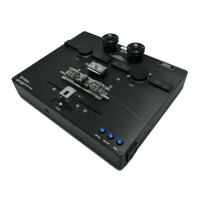FFS2000 Series Chapter 6: Fiber Preparation
Rev B, July 21, 2017 Page 33
too long, or too short as shown in the inset of Figure 37. It is fine to remove the FHB at this point and place it at
the Cleave position and check the fiber length there if necessary (if you suspect it is too short). With practice it
becomes second nature to judge the correct fiber length quite accurately.
During this process, the bottom TMS blade warms up to the preset stripping temperature, which is indicated by
the blinking strip indicator/cleave button. If it is necessary to adjust the fiber length at this point open the FHB
coating clamp and insert the fiber with the left end slightly protruding the stripper V-groove, but not extending past
the stripping blade. Figure 37 shows the Fiber length being adjusted in this way and the maximum length the fiber
should extend. The fiber will be pulled into the TMS and FHB V-groove with the activated vacuum. Gently close
the FHB coating clamp to capture the fiber.
Note: Pushing the FHB towards the stripping stop will turn vacuum and TMS heating on. Pushing the FHB away
from the stripping stop will turn the vacuum and TMS heating off.
6.2. Coating Removal
The coating removal procedure removes the acrylate coating on the fiber without scratching or abrading the
underlying glass surface. During the removal process the coating is softened, captured by a matched set of
stripping blades, and then pulled free. The fiber strength does not degrade during the stripping process since the
coating is soft when it is stripped and the stripping blades never touch the glass surface. Clean the stripping
station with the soft toothbrush (provided) or the optional vacuum cleaning system. Remove any stripped coating
or other particles from the V-grooves and around the stripper blades.
The workstation provides a chemo-mechanical in addition to thermo-mechanical method of removing the acrylate
coating. These methods differ in the process used to soften the acrylate coating. In the chemo-mechanical
method, the fiber is soaked in a solvent to swell and soften the acrylate coating, whereas the thermo-mechanical
method uses heat to soften the acrylate coating before it is stripped. The coating removal is completed by pulling
the fiber through a matched set of stripper blades that separate the coating from the glass.
Note: Some fibers may require a combination of chemo- and thermo-mechanical softening prior to stripping as
shown in Table 5.1.
The following procedures are described for the right-hand FHB. It is recommended that one begin with the right-
hand FHB to prevent the left- and right-hand fibers from crossing over at the stations. Once the right-hand fiber
has been prepared for splicing (after it has been cleaned and cleaved), follow the same procedures for the left-
hand fiber using the left-hand FHB. With practice an operator should be able to handle left and right side
operations simultaneously, greatly reducing the overall splice procedure time.
6.2.1. Setting Up
The appropriate parameters are stored as part of the Splice File. If necessary these may be adjusted from within
the Fiber Preparation menu:
Fiber Preparation Parameters
Soak Time (Chemo-Mechanical Only): Check the parameters of the ‘Soak Time’ and adjust as needed.
The soak time will need to be set to prevent the chemical agent from ‘wicking’ too far up inside the Jacket
of the Fiber, and the appropriate settings can only be determined through experimentation depending
upon the type of chemical agent employed and the particular fiber. Contact Thorlabs for assistance if
required.
Strip Set-Up: Check the parameters of the ‘Strip Set-Up’ in the ‘Fiber Preparation’ menu of the software
interface and adjust as needed.
NOTE
Parameter changes in the software interface are not saved to the configuration file (*.xml) until a file
save is executed.

